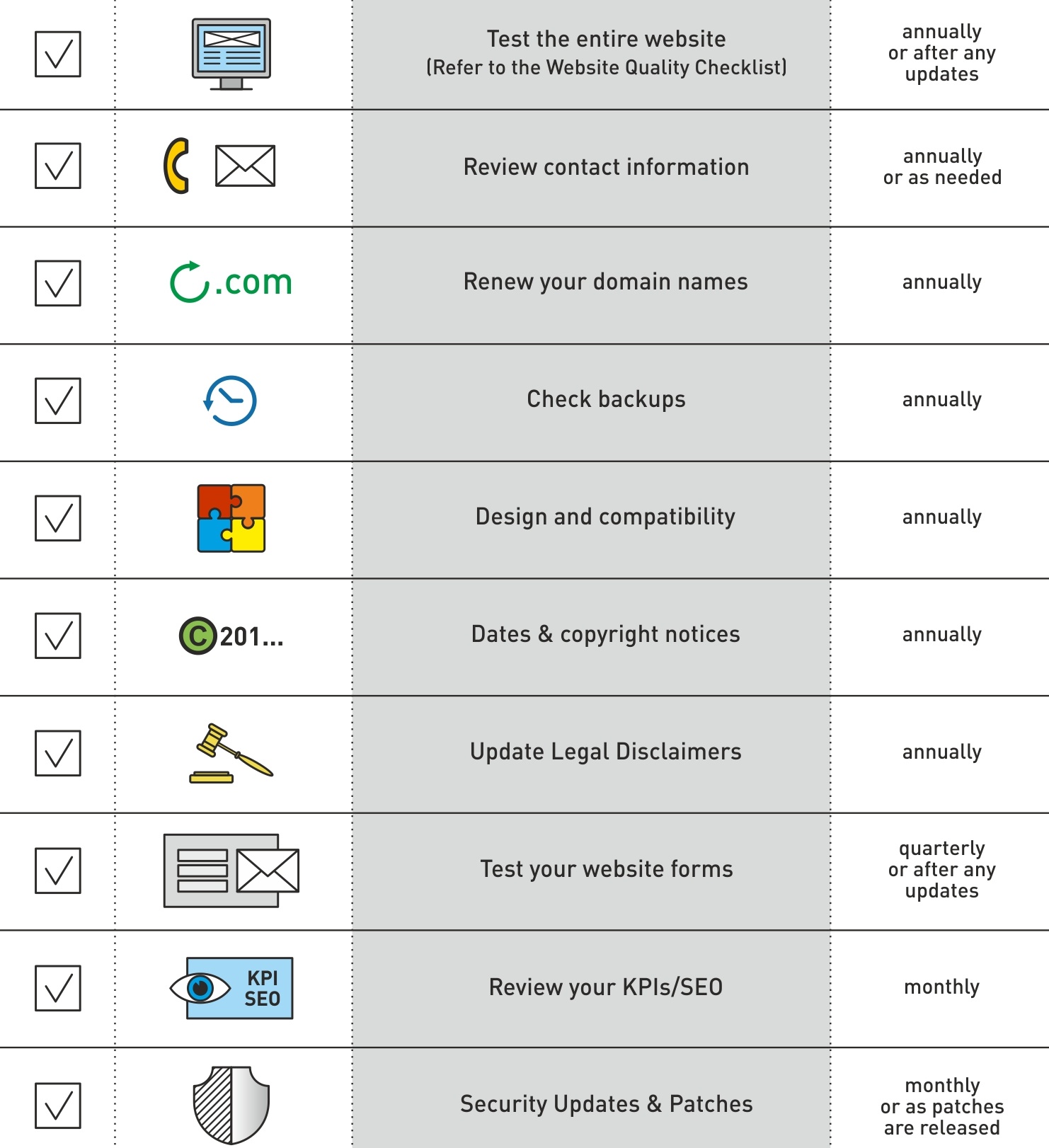 Your website is like a car. If you fail to get routine oil changes, the vehicle’s performance will continue to drop until the engine stalls. Don't let this happen to your site after all the hard work that was invested! The following 10-item maintenance checklist should be followed by you, your web developer and your hosting company:
Your website is like a car. If you fail to get routine oil changes, the vehicle’s performance will continue to drop until the engine stalls. Don't let this happen to your site after all the hard work that was invested! The following 10-item maintenance checklist should be followed by you, your web developer and your hosting company:
1. Thoroughly review and test the entire website
(annually or after any updates) Set aside time to methodically and thoroughly review all pages of the website. You may find broken links, features that don’t work or can use improvement. Pay special attention to:
- Overall user experience
- Load time
- Errors of any kind
- Broken links
- Missing or outdated content
- Missing page titles or meta tags
- Inconsistent styles or formatting
- Typos or grammatical errors
- Features and business logic
- Compliance with accessibility standards (if applicable) such as ADA (Americans with Disabilities Act)

2. Test your website forms/checkout process
(quarterly or after any updates) Make sure to regularly test all calls to action and points of contact/sale, such as Contact Us forms and the check-out process on your website. There is nothing worse than discovering your contact form stopped working after a website update, and you lost business opportunities due to this flaw.
3. Review your KPIs , SEO and analytics reports
(monthly) In order to gauge your website’s performance effectively, you must set and measure the KPIs (Key Performance Indicators), search engine ratings, and the general website analytics for at least a month. This process will indicate the effectiveness of the website and will help expose possible problems.
4. Security updates & bug fixes
(monthly or as patches are released) Be sure that both your web developer and hosting provider update the software and install any upgrades, security patches, bug fixes or any other software updates that may encompass the operating system, web server, database, CMS, etc. Ideally, patches should be installed as soon as they are released. Failure to install a security patch may compromise your website and make it vulnerable to attack.
5. Renew your domain names
(annually) Ensure that all your domain names are renewed in a timely manner. As discussed in How to Choose the Best Domain Name for Your Website, your website's domain name is your most prized possession and allowing it to expire can mean a catastrophe.

6. Check backups
(annually) Be sure that your entire website is backed up—the website itself and the data. Have your web developer or hosting company thoroughly check the backups to ensure they are working and that the data is retrievable.
7. Design and compatibility with browsers
(annually) As time passes, the website layouts or technology may become incompatible with the new browsers. Regularly review and test your website in various versions of mainstream browsers: Microsoft Internet Explorer, Google Chrome, Mozilla Firefox and Apple Safari.
8. Dates & copyright notices
(annually) Review and update any copyright dates or any date-specific text or references throughout your website. The homepage should contain no stale or outdated information (e.g., a year-old press release).
9. Review contact information
(annually or as needed) Contact information on your website should always be up to date and accurate: team member names, addresses, phone numbers, etc. A change in staff responsibilities may require e-mails are routed to a different team member. Any real-time changes to your organization should automatically trigger you to think, “Should I update the website?”
10. Review and update legal disclaimers
(annually) Review and update your privacy policy, site terms and conditions of use, terms of sale and any disclaimers to ensure they are compliant with policies and laws.
Next: How to Ensure that Your Website Doesn’t Become Obsolete


